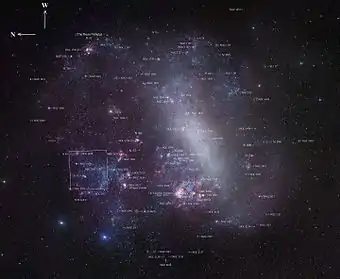NGC 2035
NGC 2035 (also known as ESO 56-EN161 and the Dragon's Head Nebula) is an emission nebula and a H II region in the Dorado constellation and part of the Large Magellanic Cloud.[2] It was discovered by James Dunlop on August 3, 1826. Its apparent size is 3.0.[3]
| Nebula | |
|---|---|
 | |
| Observation data: epoch | |
| Right ascension | 05h 35m 30.0s[1] |
| Declination | −67° 35′ 00″[1] |
| Apparent dimensions (V) | 3.0 |
| Constellation | Dorado |
| Designations | ESO 56-EN161, Dragon's Head Nebula |

The Large Magellanic Cloud, with the location of NGC 2035 and NGC 2032 marked just left of centre
NGC 2035 is part of a complex of nebulae and stars, including NGC 2029, NGC 2032 and NGC 2040, found north of the main bar of the LMC. It consists of large bright gas clouds which are separated by dark dust clouds. NGC 2029, NGC 2032 and NGC 2035 are star-forming regions, while NGC 2040 is a supernova remnant which contains an open cluster.[2][4]
References
- "Bright Nebula NGC 2035". dso-browser. Retrieved 9 October 2017.
- "Forging Stars – Peering Into Starbirth and Death". Universetoday. 27 November 2013. Retrieved 9 October 2017.
- "NGC 2035 (= EN in LMC)". cseligman. Retrieved 9 October 2017.
- "VLT Sees Dragon's Head Nebula in Large Magellanic Cloud". sci-news. 27 November 2013. Retrieved 9 October 2017.
This article is issued from Wikipedia. The text is licensed under Creative Commons - Attribution - Sharealike. Additional terms may apply for the media files.